2019 Building America Report Menu
Engaging Employees
Union Pacific’s employees are passionate about their role Building America. We believe the work that every employee does matters, and how the work is accomplished is just as important as producing results and achieving goals. Every employee’s career path is unique, from an office setting to working on or with trains. At Union Pacific, we help employees develop skill sets enabling them to grow, move into positions across the company and become experts in their role, leading to fulfilling careers.
The work we do moving customers’ goods and providing shareholder value is not possible without the hard work and dedication of our employees. As we implemented Unified Plan 2020, we found efficiencies that resulted in a workforce reduction, impacting management and union employees. Union Pacific does not make these decisions lightly, but we know they are critical to our company’s vibrancy in future generations.
- Embracing Employee Needs
- Building Employee Engagement
- Developing Employees
- An Embedded Ethical Approach
- Diversity, Equity and Inclusion
- Keeping Employees Healthy and Well
- What's Ahead
Locomotive Engineer Janet Schultz celebrated her 40th year with Union Pacific in 2019.
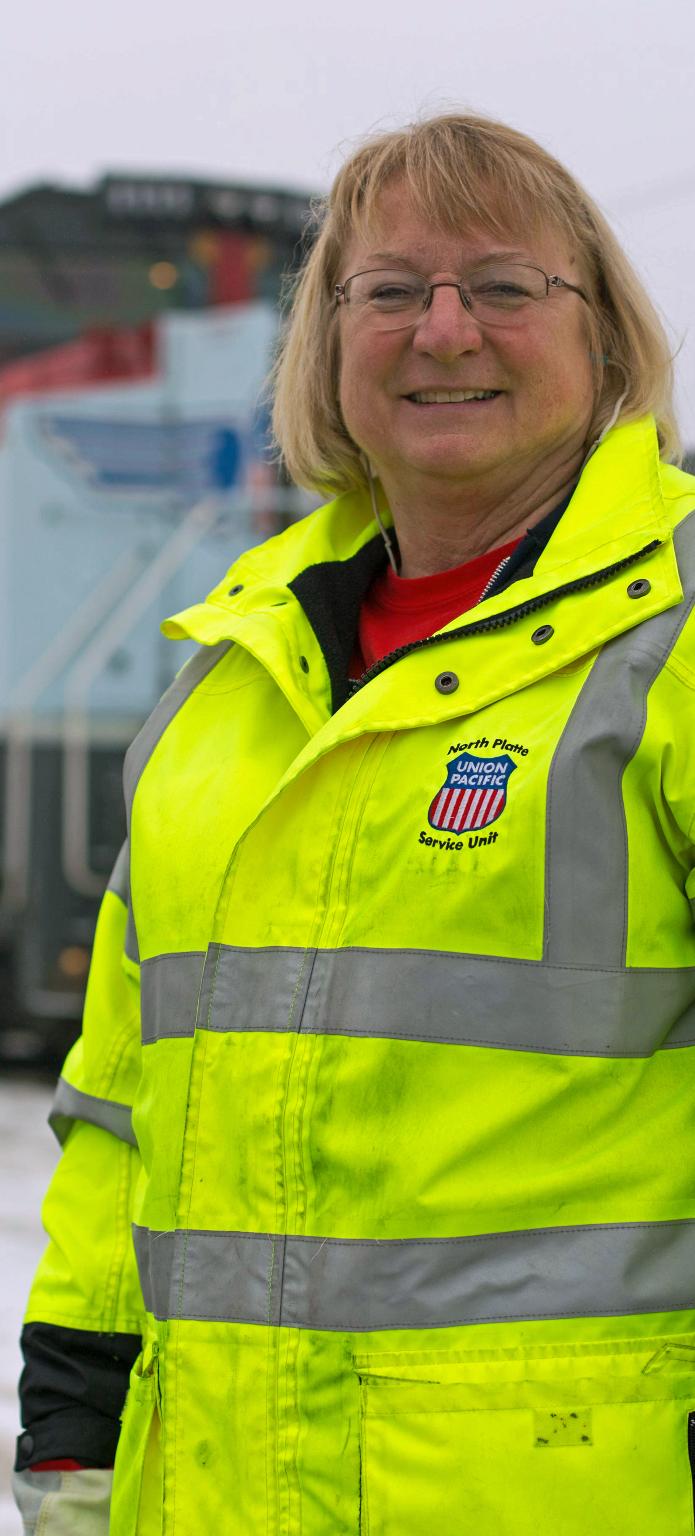
Embracing Employee Needs
Union Pacific is a company that is always moving, advancing and building. We have the best employees in the industry, and we are dedicated to engaging them and motivating them to unlock new levels of passion and dedication while leveraging their diverse talents.
When we launched Unified Plan 2020, we indicated there would be workforce reduction initiatives, which would likely continue through 2020. Uncertainty with trade contributed to volume decline of approximately 6% for the year compared to 2018, requiring us to further reduce our workforce to align with customer needs. Although difficult, these changes are critical to ensure Union Pacific remains a strong and competitive company.
Providing employees with fulfilling, family-supporting careers is important to us. We offer competitive compensation to our employees and leadership. Our board of directors evaluates our compensation plans and reviews recommendations from the Compensation and Benefits Committee. The median annual total compensation for all our employees who were employed as of Dec. 31, 2019, was $79,446. The annual total compensation for Chairman, President and CEO Lance Fritz was $15,018,400, resulting in a pay ratio of 189:1. Additional information about our executive compensation structure is available in the 2020 Proxy Statement.
| Population (Total Company) | ||
|---|---|---|
| Approximately | 37,500 | |
| Female | 5.5% | |
| Male | 94.5% | |
| Asian | 2% | |
| Black | 12% | |
| Caucasian | 71% | |
| Hispanic | 14% | |
| Native American | 1% | |
| Traditionalists (born before 1946) | <1% | |
| Baby Boomers (born 1946-1964) | 21% | |
| Generation X (born 1965-1981) | 55% | |
| Millennial (born 1982-1997) | 23% | |
| Generation Z (born after 1998) | <1% | |
| Senior Management | ||
|---|---|---|
| Female | 23% | |
| Male | 77% | |
| Asian | 2% | |
| Black | 6% | |
| Caucasian | 86% | |
| Hispanic | 6% | |
| Native American | 0% |
Executive Staff
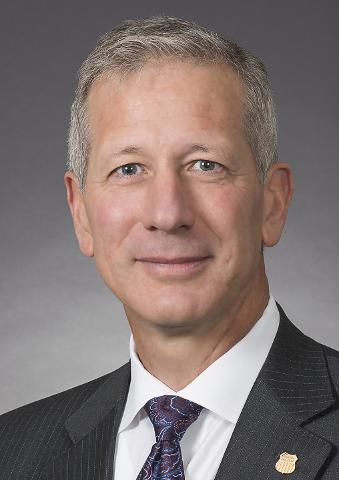
Lance Fritz
Chairman, President and Chief Executive Officer
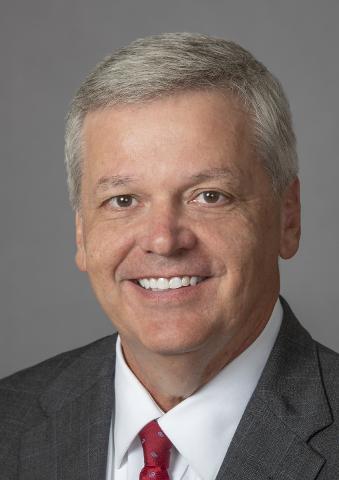
Printz Bolin
Vice President – External Relations
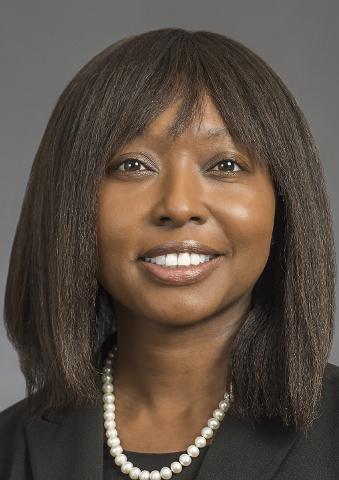
Rhonda Ferguson
Executive Vice President, Chief Legal Officer and Corporate Secretary
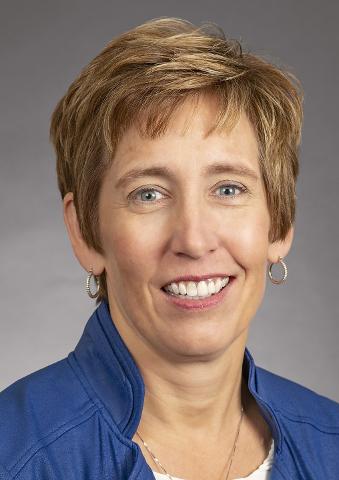
Jennifer Hamann
Executive Vice President and Chief Financial Officer2
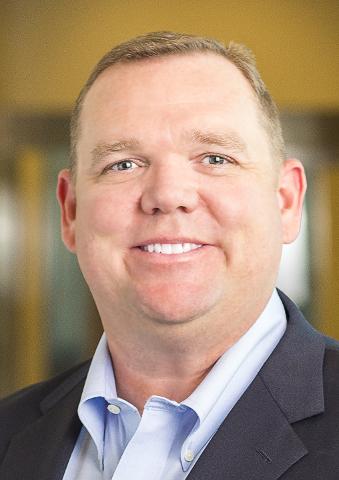
Thomas Lischer
Executive Vice President, Operations
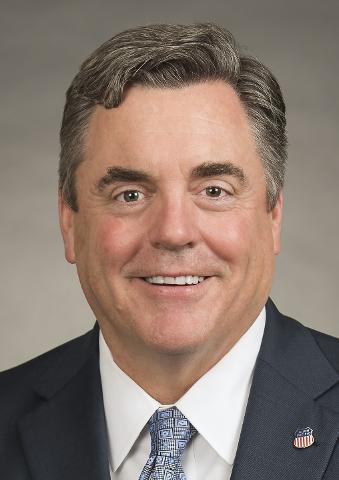
Scott Moore
Senior Vice President – Corporate Relations and Chief Administrative Officer
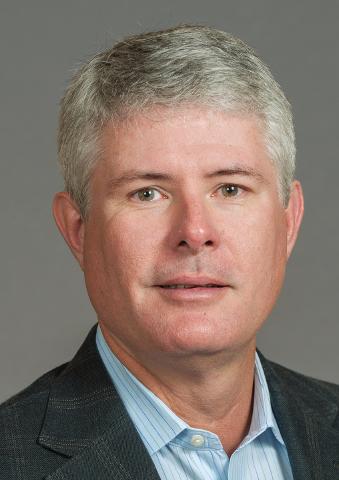
Clark Ponthier
Senior Vice President – Supply Chain and Continuous Improvement
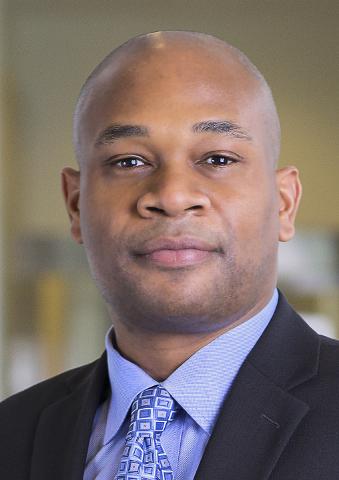
Kenny Rocker
Executive Vice President, Marketing and Sales
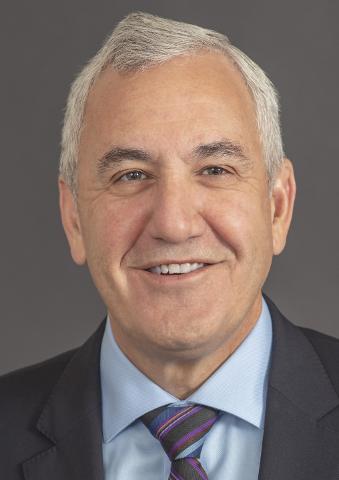
Jim Vena
Chief Operating Officer
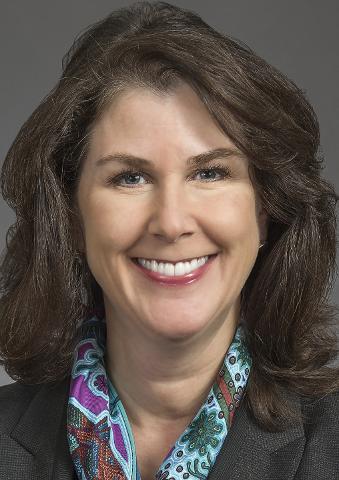
Beth Whited
Executive Vice President and Chief Human Resource Officer
2 Jennifer Hamann succeeded Rob Knight, who retired in 2019 following 39 years of service at Union Pacific.
Building Employee Engagement
When employees are empowered and respected, they feel connected to the company. Union Pacific believes every employee needs to be engaged in making his or her work safer and more productive.
Employees had an opportunity each quarter to provide feedback through anonymous online surveys. Participation rates and Union Pacific’s Employee Engagement Index, our measurement of the current engagement level, dropped every quarter. Given the workforce reduction and changes implemented with our new operating strategy, a drop in scoring was not unexpected. We know we have work to do, and we are committed to listening to our employees’ feedback and finding solutions. All employees, regardless of craft, location or title, want to be shown appreciation by their managers, understand how they fit into the company’s strategy and be kept in the loop by local leadership.
As a direct result of engagement survey feedback, we worked with employees to implement a new field testing program called COMMIT for Train, Engine and Yard (TE&Y) employees. COMMIT, which stands for Coaching, Observing, Mentoring and Motivating with Integrity and Trust, focuses on results-based, in-person coaching interactions instead of discipline. The modernized program simplified our rules structure, focusing on 30 critical rules compared to the previous 3,000.
“During our research, we discovered 80% of safety incidents occur within only six types of activities,” said Erin Batt, assistant vice president and chief safety officer. “By shifting our focus to what is actually happening and not what could potentially happen, we help eliminate our highest risks and drive our safety numbers to the ultimate goal of zero incidents.”
Field managers believe COMMIT is making a positive impact. One element is “On the Job Engagements,” allowing managers and employees to interact one-on-one and address issues beyond safety. For example, when an employee identifies a hard-to-throw switch that needs attention, they work together to solve the problem.
“We’re treating others the way we want to be treated – with respect,” said Mike Santa Maria, general manager-Transportation, Great Plains Service Unit. “After spending an hour with someone switching, it’s amazing how quickly you find common ground you may not have otherwise experienced. We’re building relationships, trusting one another and having respectful conversations.”
Unveiling No. 1111 – the Employee Pride Locomotive
In our nearly 160 year history, we’ve only created 17 commemorative locomotives. Some pay homage to our predecessor railroads that merged to create today’s Union Pacific, while others recognize important organizations in American society. As we celebrated the 150th anniversary of the transcontinental railroad’s completion in May, we wanted to honor the one thing that remains the same – our employees, who are the heart of the railroad. The Employee Pride Locomotive is the first commemorative locomotive dedicated to honor the men and women of Union Pacific. UP No. 1111 represents our goal to be the No. 1 railroad with the No. 1 employees who have the No. 1 dedication to safety with 1 vision – Building America. The locomotive’s design was selected by employees. It represents various crafts and departments, as well as the diverse community landscapes employees serve each day. No. 1111 was officially unveiled at an employee celebration in Omaha, Nebraska, and is now traveling the system pulling customer freight.
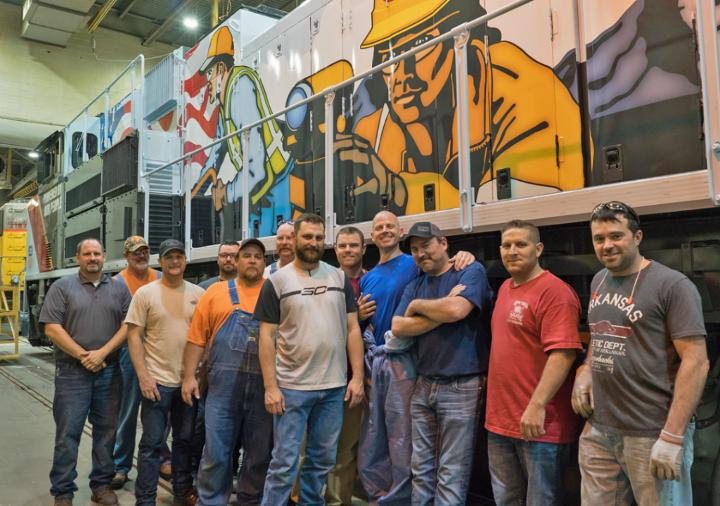
Jenks Shop employees who blasted, sanded, stripped, painted and decaled the Employee Pride Locomotive take a photo before it pulls out of the shop.
Providing Meaningful Benefits
We offer a comprehensive benefits program, including medical insurance, Railroad Retirement and 401(k), as well as niche benefits employees may find useful at various life stages. Benefits vary based on the applicable collective bargaining agreement or an employee’s non-union status. As our company and workforce continue to evolve, so must our practices and policies.
At a Southern Region employee town hall meeting early in the year, Beth Whited, executive vice president and chief human resource officer, was asked how Union Pacific can better support employees and their family life. A special project team was created, made up of Workforce Resources and members of our women’s Employee Resource Group, LEAD. The team decided to focus on women in Operating after looking at employee engagement survey data. A follow-up survey of approximately 1,000 female employees found nearly half plan to start a family; however, many don’t believe they can do so and continue their current job. Feedback centered around 24/7 child care options and early parenthood support.
We made some immediate changes. For example, all lactating agreement and nonagreement employees are now provided free overnight shipping of breast milk when traveling for work through Milk Stork. The program allows employees to continue providing for their children without the added stress of getting the milk home. Union Pacific also implemented an enhanced maternity leave benefit. Women now receive six weeks of paid leave in addition to the existing short-term disability benefit for normal delivery or eight-week benefit for cesarean section delivery.
“We are not trying to solve ‘mom’ problems, but create solutions for the whole family,” said Carrie Jensen, manager-Training Delivery, Workforce Resources. “The ultimate goal is to provide a healthy balance for all employees, building an inclusive workplace that is thriving with diverse, engaged employees.”
We are proud of our benefit offerings; however, work schedules required to operate our railroad’s 24/7 operations can be challenging, and employees often need extra support caring for loved ones. The Bright Horizons Care Advantage™ database refers employees to supportive care providers and services, such as:
- Center-based and in-home child care.
- Elder care.
- Pet care.
- Housekeeping.
- Tutoring and homework help.
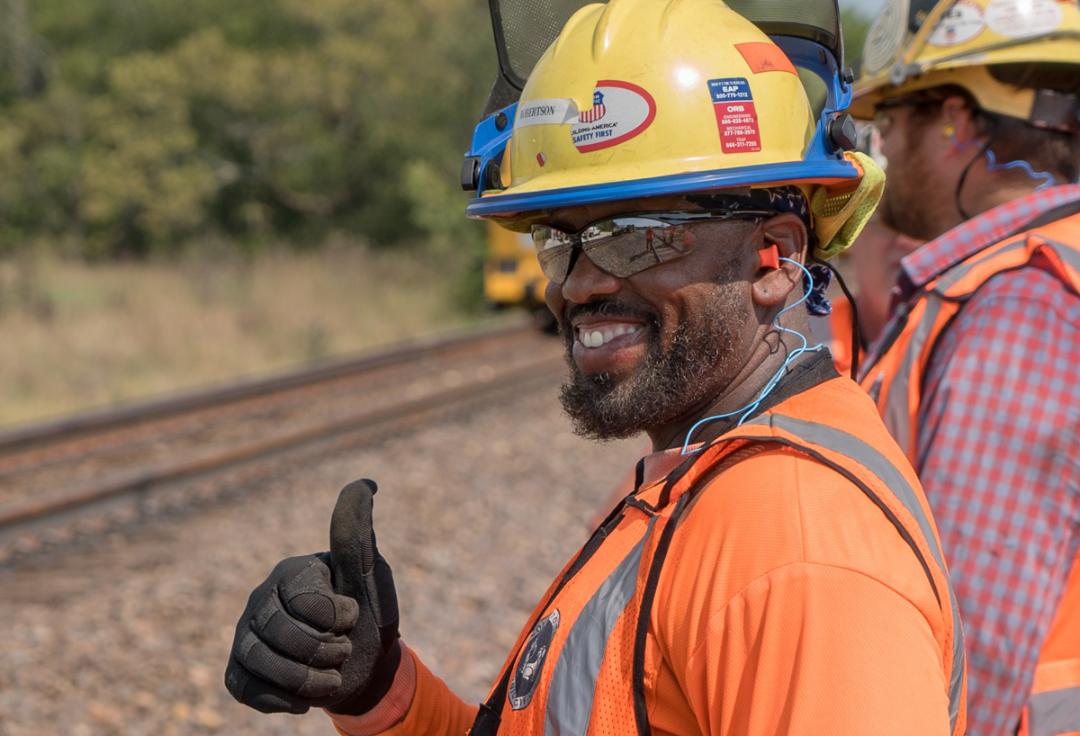
Machine Operator Ricky Robertson is part of a system track gang working in Garnett, Kansas.
Labor Agreements
Union Pacific works with 15 major rail unions representing approximately 85% of our roughly 37,500 full-time employees.
In November, the National Railway Labor Conference announced that its members, including the nation’s largest freight railroads, launched a new bargaining round with 13 labor unions representing more than 142,000 unionized employees industry-wide. In delivering Section 6 bargaining notices to the labor unions, the railroads stressed that reaching new, modernized labor agreements can ensure railroad employees remain one of the nation’s best-compensated workforces.
Key issues being negotiated include wages, health care benefits and work rules. New agreements will allow railroads to leverage transformational technologies, including developments in automation and safety to help manage an uncertain economy and long-term structural changes in transportation and rail traffic.
The majority of unions and more than 45 railroads participate in negotiations on a national multi-employer basis. The National Carriers Conference Committee (NCCC) of the National Railway Labor Conference, consisting of the top labor officers of Class I railroads, is the bargaining committee for the carriers.
Railroads are governed by the Railway Labor Act (RLA), a federal statute enacted in 1926 to bring the railroads and unions to agreement without disruptions to rail transportation. The RLA includes numerous safeguards to help overcome bargaining stalemates.
Under the law, collective bargaining agreements remain in force indefinitely until the parties agree to change them. Without contract expiration dates, negotiators don’t work against a fixed deadline. Instead, they proceed through a structured and regulated process.
Auxiliary Work And Training Status (AWTS)
Shifts in business demand resulted in temporary reductions to train and yard service (TE&Y), causing employee furloughs. A furloughed employee is placed on an inactive board and not subject to call, unless the union agreement they work under has specific stipulations. In approximately 75% of Union Pacific’s work locations, furloughed TE&Y employees were eligible to be covered under Auxiliary Work and Training Status (AWTS) agreements providing limited benefits. These agreements must also be approved by local unions.
AWTS agreements provide up to eight work or training days per month, and continue full health care benefits and service months contributing to Railroad Retirement. Employees continue training to sharpen their skills and prepare for full-time employment when customer demands increase.
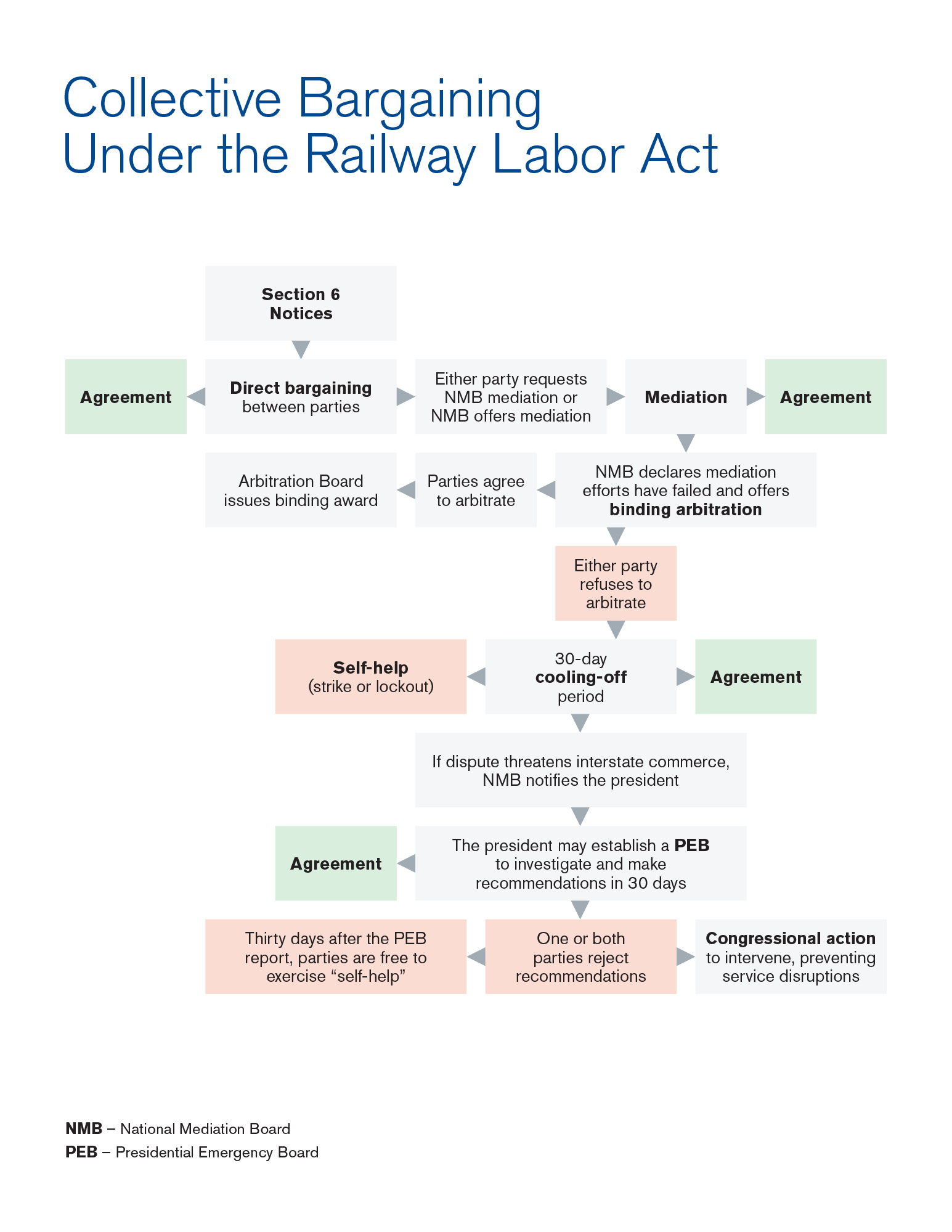
Developing Employees
The work of building, maintaining and operating a railroad is challenging. Union Pacific’s commitment to employee training and development is vital for cultivating the high-quality workforce we need. It also plays a critical role keeping our employees safe, ensuring we operate ethically and retain an engaged workforce.
Employee Retention*
Operations Management Trainee
| 2015 | 36% | |
| 2016 | 33% | |
| 2017 | 41% | |
| 2018 | 69% | |
| 2019 | 84% |
Field Management Trainee
| 2015 | 58% | |
| 2016 | 59% | |
| 2017 | 78% | |
| 2018 | 82% | |
| 2019 | 97% |
*This chart reflects end-of-year retention numbers. As employees leave the company over time, statistics for previous years are updated. For example, 36% of the OMTs hired in 2015 are still with Union Pacific.
Union Pacific Recognizes 50-Year Employees
1969 was quite the year. The first human landed on the moon, the famous Woodstock Festival attracted nearly half a million people and the nation celebrated the 100-year Golden Spike anniversary. It also was the year Alma Hill and Bruce Rice became railroaders.
Hill joined the railroad as a file clerk in Houston, Texas. Over her career, she moved more than seven times, working as a file clerk, utility clerk, dispatcher clerk, assistant chief clerk and revenue accountant, among other positions. Her co-workers describe her as hard-working, dependable and positive. She currently works in Kansas City as a utility clerk and mentors younger employees.
Rice was hired out by the Missouri Pacific as a fireman. The Missouri Pacific later merged with Union Pacific, and Rice spent the majority of his career in the cab of a locomotive, traveling from Salem, Illinois, to Poplar Bluff, Missouri, or Salem to Dexter, Missouri. The locomotive engineer’s co-workers say his knowledge was extensive, and he could run a train by feel. Rice retired in July.
The honorees were recognized by Chairman Lance Fritz, senior executives and their peers at a May celebration at Union Pacific Center in Omaha, Nebraska. They also toured Heritage Park and the Union Pacific Museum in Council Bluffs, Iowa, reliving some of the railroad history they witnessed firsthand.
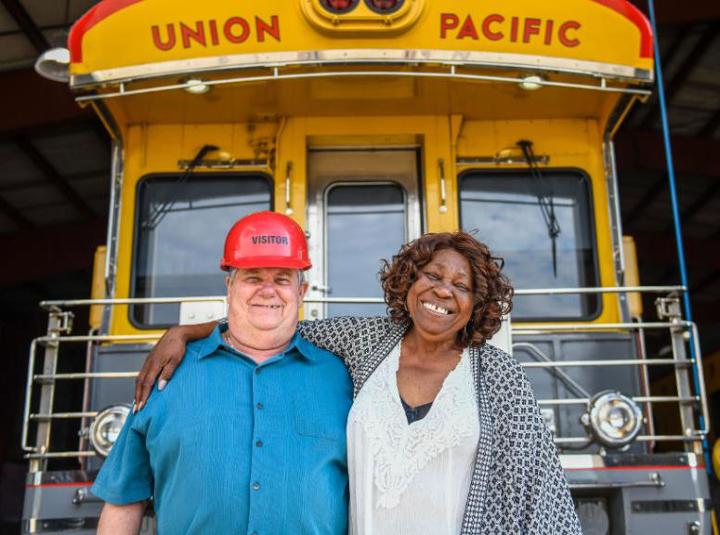
Bruce Rice, left, and Alma Hill visit Heritage Park in Council Bluffs, Iowa.
Developing Skills
Our training and development focus on setting goals and achieving great results. We invested approximately $34.5 million to develop and deliver a wide range of training to our employees. Of our 37,500 employees, 100% participated in training activities.
Our core competencies foster a culture of performance and growth supporting our vision, purpose and values. In addition to work-related skills, we develop employees’ capabilities in eight core competencies:
- Building relationships and influencing others.
- Handling adversity.
- Confronting problems with courage.
- Leading teams.
- Embracing change.
- Making effective decisions.
- Acting strategically.
- Focusing on customers.
We offer skill development opportunities for employees at all levels. These include:
- New Employee Onboarding Program – Courses on communication and industry-specific training through interactive experiences.
- Skill Development – Technical, communication, safety and environmental courses.
- Managerial and Leadership Development – Management and leadership courses helping employees grow and develop.
- Transitioning Managers – Courses helping newly promoted managers lead teams.
- Transportation Operations Training – Operational excellence courses strengthening employee skills and training for superior service.
- Field Management and Operations Management Training Programs – Programs preparing employees for frontline management positions within the Operating Department.
Enhancing Skills Through Simulator Training
Imagine taking control of a 200-ton locomotive, pulling dozens of cars loaded with lumber, cheese and consumer products, and navigating across changing terrain. Our locomotive engineers take the throttle and succeed in many scenarios just like this before actually stepping inside the cab.
Union Pacific uses 39 full-size locomotive simulators to replicate the experience of operating a locomotive along our tracks. It gives employees an opportunity to experience multiple terrains and react to different scenarios.
We have three mobile training trailers, each equipped with 13 workstation simulators and 25 laptop simulators. This equipment supports Positive Train Control implementation. Although we’ve completed required employee training, we continue to use these trailers to train new employees and provide any refresher training our current staff may want or need.
Union Pacific uses Remote-Controlled Locomotive (RCL) simulators to provide hands-on training for licensed remote-control operators. In their daily work, these employees use a small computer console to direct locomotives inside rail yards. We plan to continue using simulators for new hire conductor and RCL classes.
| 2017 | 2018 | 2019 | |
|---|---|---|---|
| Locomotive simulator | 20,000 hours | 20,600 hours | 18,000 hours |
| Mobile PTC simulator | 5,350 employees | 2,560 employees | 60 employees3 |
| RCL simulator | 7,000 hours | 9,500 hours | 5,460 hours |
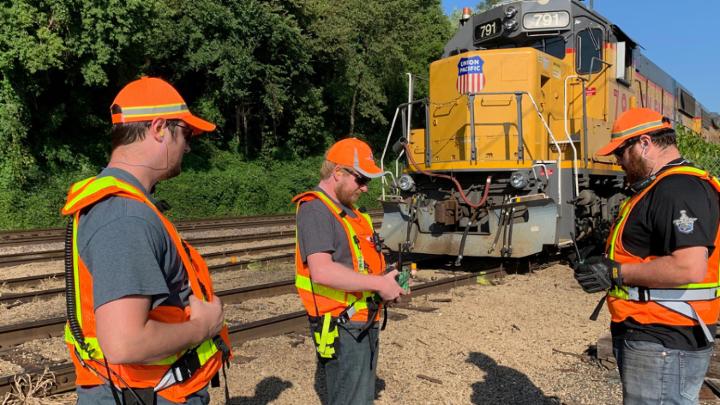
Instructors provide hands-on RCL training in St. Paul, Minnesota.
3 Union Pacific completed its required training; however, PTC education is ongoing as we retrain employees and introduce the system to new hires.
A Modernized Approach To Training
Without laying a track, it’s impossible to operate a train. Similarly, without laying a foundation of knowledge, it’s impossible to advance and diversify one’s skill set. We centralized our departmental training functions, combining them into one team within Workforce Resources and, at the same time, found ways to modernize training based on employee feedback. We’re emphasizing training in the field, rather than a classroom, and offering it when employees need it so it will be top of mind. We’re using more simulators and bite-sized resources to solve real-world issues in real time. We’re also leveraging “Go and See” activities and cross-functional discussions, as well as offering certification programs for employees to refresh their skills.
Teamwork Starts on Day One
We redesigned our Operations Management Training (OMT) and TE&Y new hire programs. TE&Y employees are responsible for building and moving trains. OMT graduates become the managers who oversee this work. Following orientation, the two groups join forces for an eight-week, field-focused training class, learning side by side in a mock Operating environment.
“We are showing participants that railroading is a partnership,” said Lydia White, manager-Training Delivery, Workforce Resources. “To be the best freight railroad and practice excellent customer service, we need to work together.”
The redesigned training programs reduce TE&Y new hire cycle time (from hire date to application of training principles), from 17 weeks to eight weeks, and OMT cycle time from about 10 months to five months. Nearly every participant in the pilot gave positive feedback on the new training program, saying it better prepared them to immediately start work in the field.
Engineering Receives Trackside Training
As technology evolves, so does the work our Engineering staff performs, requiring continuous education. We’re sending instructors into the field to provide onsite training for positions such as track foremen and inspectors, tamper and crane operators, work equipment mechanics and Signal employees.
“Structured field training provides employees an opportunity to receive immediate feedback, giving them a clear picture of how to safely and successfully complete their jobs,” said Ron Speer, manager-Technical Training, Workforce Resources.
Workforce Resources also uses mobile simulation for cranes, boom trucks and those working with air brakes and hotbox detectors. Simulation allows employees to learn or improve a skill, and then perform specific testing or inspections on their own with an instructor present for reinforcement, if necessary.
More than 12,000 employees have attended one of 65 classes on topics ranging from crossing warning and cutover to coded track circuits, hotbox detectors and Positive Train Control (PTC). From Baton Rouge, Louisiana, to Hermiston, Oregon, one- to three-day training classes have been conducted in all 23 states where we operate.
Dispatching with Excellence
Dispatchers control train movement across our network, coordinating hundreds of trains every day. One train stopping or reducing speed increases potential safety risks and slows down customers’ goods. However, dispatchers can’t solve this problem alone. We piloted a new program, Dispatching with Excellence, focusing on ways dispatchers can better communicate with locomotive engineers. They rely on dispatchers to look ahead, give warnings and serve as a guide on their trip. By better communicating any foreseeable issues with train crews, we expect to reduce unplanned stops and slowdowns, and improve reliability and network fluidity.
Mastering GE AC4400 Locomotives
General Electric’s (GE) AC4400 locomotives have been a staple in our fleet for years, and now we’re retrofitting them with new control systems, creating the need for experienced machinists and electricians to become experts on the new technology. Union Pacific worked with GE to design a certification program that incorporates online classes, classroom instruction and on-the-job training with a GE-technical advisor and one of our certified trainers. More than 50 Union Pacific machinists and electricians have graduated from the program, receiving a GE4400 Certification jacket, hard hat sticker and certificate.
Emerging Leaders
We launched a new program designed to inspire early-career employees by investing in their development and positioning them for career progression. The hand-selected employees participate in an eight-week program designed to teach them how to effectively manage change, build relationships, influence their peers and manage conflict. After learning these skills, participants select a volunteer opportunity to hone their abilities and a mentor from outside their department to help them practice long-term relationship-building skills.
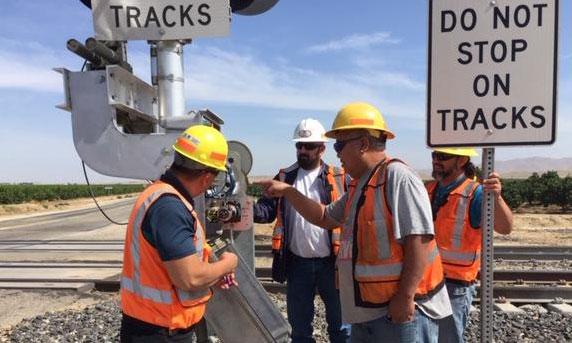
Workforce Resources Senior Instructor Archie Niebres provides signal training to three Engineering signal maintainers: Andrew Cerda, Jack Juanillo and Gerardo Monge.
An Embedded Ethical Approach
Union Pacific’s reputation and success are determined by the decisions we make as employees and as a company, and by the people with whom we choose to do business. Providing the training and tools needed to help employees make the right decisions is a priority.
Our policy on Ethics and Business Conduct, The How Matters, explains our expectation of ethical conduct, prohibiting offensive remarks and sexual harassment, among other violations. We have a zero tolerance policy on inappropriate behavior involving Equal Employment Opportunity (EEO) and retaliation, encouraging employees who witness behavior they believe violates EEO policy to report the incident.
Union Pacific employees operate under the following high ethical standards:
- Honesty – Being truthful when dealing with customers, suppliers, shareholders and fellow employees.
- Fairness – Treating everyone fairly.
- Integrity – Voicing concerns when we believe our company or colleagues are not acting ethically or complying with the law.
- Respect – Maintaining a foundation of trust and respect with colleagues, customers, regulators, suppliers and other stakeholders.
- Loyalty – Ensuring no employee is, or appears to be, subject to influences, interests or relationships that conflict with the company’s best interests.
- Accountability – Holding ourselves, peers and customers to the company’s high ethical standards.
- Adherence to the law – Complying with all laws.
- Compliance with policies – Complying with the letter and spirit of company policies.
Ethics Awareness
Union Pacific educates employees about ethics and our expectation of high ethical conduct throughout the year. We focus on The How Matters and the premise that how we do our jobs is as important as what we accomplish. Published articles on our employee news website, regular ethics bulletins and mandatory training modules remind employees of Union Pacific’s high ethical standards.
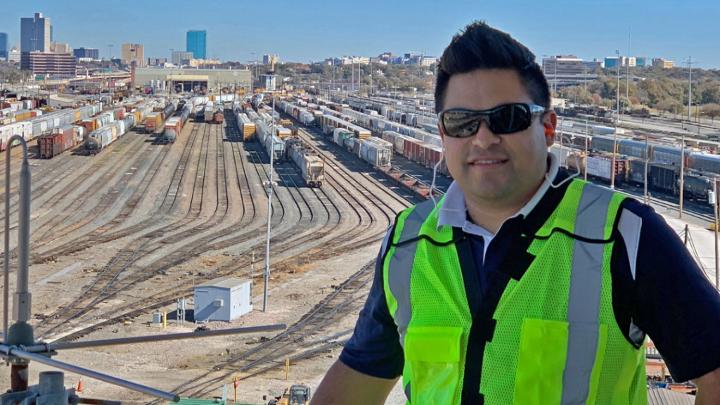
Gonzalo Vasquez III, senior manager-Train Operations, in the tower overlooking Davidson Yard in Fort Worth, Texas.
Continuous Improvement the UP Way
The UP Way engages all employees to continuously improve safety, service and efficiency by providing methods, tools and processes to standardize work, eliminate variability and waste, and solve problems at the root cause. We use the following primary UP Way tools to achieve continuous improvement (CI):
- Standard Work – Operations are performed in a consistent manner and are regularly improved by employees doing the work, improving engagement and reducing variability.
- Leader Standard Work – The audit function of the UP Way suite of tools; utilized to ensure improvement is sustained by engaging and developing employees.
- 5S (Sort, Straighten, Shine, Standardize and Sustain) – The workplace is cleaned and organized in a systematic process, improving our work areas and increasing efficiency.
- Value Stream Mapping – A map-like illustration that shows the flow of the process, information, materials and cycle times, allowing us to process constraints and eliminate waste.
- Problem Solving – A process for analyzing problems to determine the root causes in order to solve the problem for the last time.
- Visual Management – Work cues that indicate process performance for all employees, providing opportunities to improve and understand processes.
Employees who have a passion for improvement may apply for our UP Way Certification Program. This nine-month program pairs the employee with a mentor while they are trained in CI and gives them an opportunity to use their skills to complete improvement projects within their department. Since it began in 2013, more than 245 employees have earned a UP Way certification through the program.
Identifying the Root Cause
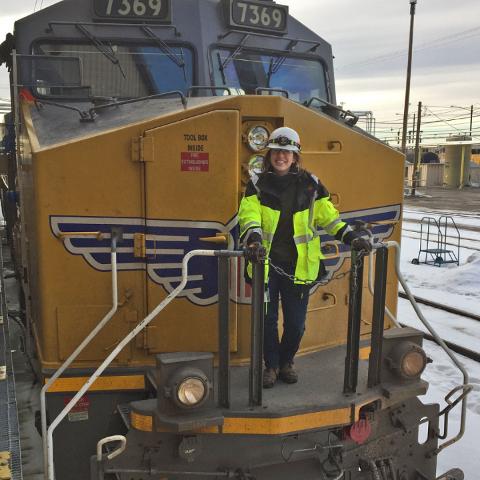
Mary Pistillo aboard UP7369.
Union Pacific locomotives are running more reliably thanks to UP Way graduate Mary Pistillo, senior engineer-Locomotive, Mechanical, who used problem-solving tools to find and address the root cause of the C44 fleet’s fuel injection pump failures. Pistillo worked with the locomotive maker, discovering the problem that led to most of the fuel injection pump issues. She instituted a new maintenance procedure to catch the problem in the shops. At the same time, the locomotive maker redesigned the pump and developed new software that Union Pacific is systematically installing. Digging into this project helped Pistillo achieve her goal of zero failures or service interruptions after locomotives leave the shop.
“If you find and fix the true root cause, then a problem can be solved once, allowing you to move on,” Pistillo said.
Standardized Safety Check
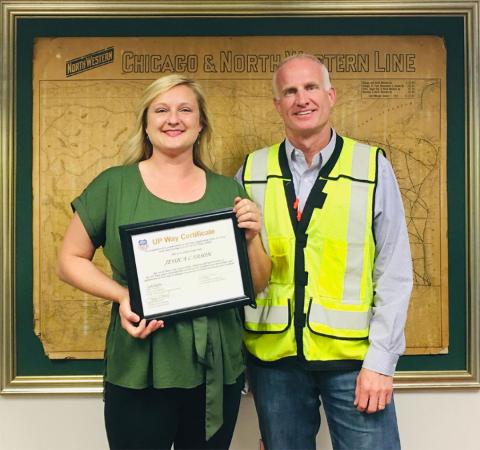
OHN Jessica Carson, left, and Senior Vice President – Transportation, Northern Region Shane Keller at Carson’s UP Way graduation.
Occupational Health Nurses (OHNs) are located across Union Pacific’s 23-state system. They are responsible for preventing and responding to injury and illness, as well as promoting health and safety. OHN Jessica Carson created Standard Work that is now used systemwide by OHNs participating in monthly leadership site visits, helping them take a strategic and proactive approach to employee health and wellness. For each visit, OHN Standard Work includes promoting wellness programs, conducting health screenings and completing a Safety Audit Checklist. The checklist means OHNs know the status and location of critical items, such as AEDs, First Aid kits and Personal Protection Equipment supplies, preparing them to handle any situation.
“When you go to an emergency room, you want every staff member to know exactly where everything is,” Carson said. “For Union Pacific’s OHNs, increased efficiency means improved employee safety.”
Diversity, Equity and Inclusion
Union Pacific is committed to improving and strengthening performance through an inclusive workforce that reflects the diverse markets and communities we serve. Recognizing we still have work to do, we continue to focus on building an inclusive culture, and a talented workforce and marketplace.
Our diversity council, chaired by our chairman, president and CEO, provides frontline insight and reports quarterly to senior management. We also have an Employee Resource Group (ERG) Steering Committee that oversees our nine ERGs. These groups are critical to supporting the company's diversity and inclusion strategy by raising awareness and providing an environment where all employees can realize their potential.
Attracting, acquiring and maintaining a diverse workforce provides access to the skills and character we need to foster innovative ideas and drive optimal business growth. Drawing on different experiences and expertise is critical for strategic decision-making, problem-solving, leadership development and creativity.
We recruit talented individuals dedicated to our mission of service and passionate about performing to the best of their abilities while working as one team. We recognize and value that people come from all backgrounds and walks of life, and embrace those with cognitive diversity. Union Pacific wants employees from all groups to launch and grow their career within the company.
Fostering Equality
Union Pacific employees have the fundamental right to fair treatment within a discrimination-free workplace. We create a work environment that respects and values differences, which is essential for employees to reach their fullest potential.
We are committed to a work environment free of offensive behavior regarding a person’s race, color, national origin, religion, gender, sexual orientation, age, gender identity, veteran status or disability. This includes offensive behavior directed at employees, customers, visitors to company facilities and others who employees may contact during the normal course of work.
The Human Rights Campaign Foundation publishes a Corporate Equality Index (CEI), identifying America’s most and least LGBTQ-inclusive companies. Scores, from zero to 100, measure the treatment of LGBTQ employees and are based on a company’s non-discrimination policies, employment benefits, efforts to support an inclusive culture and responsible citizenship. We enhanced our benefit offerings for same and different-sex partners, expanded our anti-discrimination policy to the Community Ties Giving Program and added LBGT to our Supplier Diversity Program’s anti-discrimination policy. We are proud of the work we did in 2019 to improve our score from 80 to 95 on the newly released 2020 CEI.
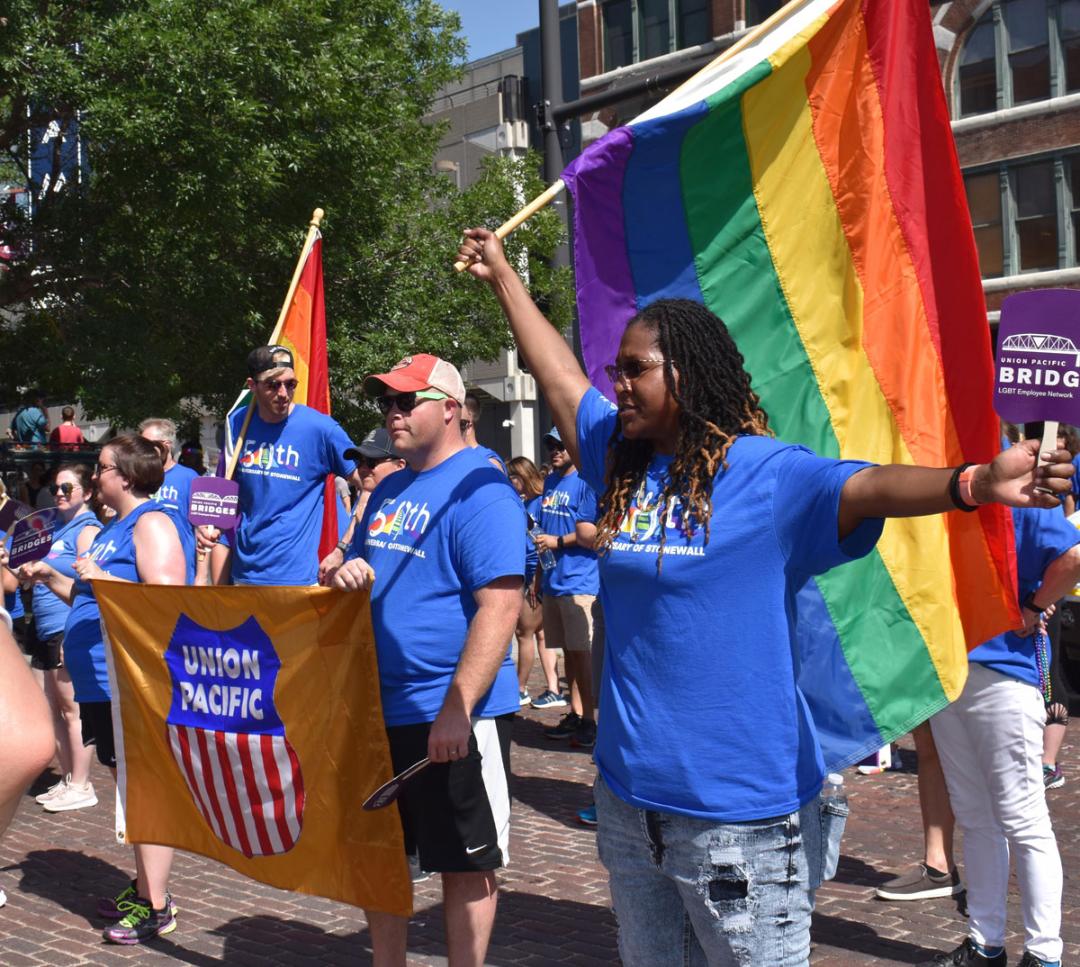
Employees from Union Pacific’s LGBT Employee Resource Group, BRIDGES, participate in Omaha’s Pride Parade. A rainbow flag was flown at Union Pacific Center to mark the weekend.
Inclusive Leadership
Diversity and inclusion aren’t just values to live by; they have real impact on business outcomes. According to a McKinsey study, 33% of ethnically diverse companies have industry-leading profitability, and companies in the top quartile for gender diversity are 27% more likely to outperform their peers on value creation.4
Understanding the significance of these potential impacts, we created an unconscious bias training course called Inclusive Leadership. The four-hour class helps employees better understand unconscious bias and the impact it can have, as well as empowers them to see it and take action. Our goal is for Union Pacific employees to lead by example and demonstrate inclusive behavior at work and in their communities.
More than 2,400, or approximately 93%, of required managers completed the in-person Inclusive Leadership class. The training is required for executives, senior managers and anyone with direct reports. An online version was deployed late in the year, giving us an opportunity to equip additional employees with this critical training.
Leading By Example
At Union Pacific, diversity, equity and inclusion are more than a goal – they are a responsibility. These values are core to who we are, and employees must lead by example in our communities, ensuring they extend beyond the rail yard and office. We want employees to live and work in communities where they feel inspired, and that means interacting with people who have different opinions, backgrounds and experiences.
We’ve called Omaha, Nebraska, home for nearly 160 years, and we’re building our future here – one that’s based on equal opportunity. We are proud to work with the Greater Omaha Chamber on collaborative efforts to engage the business community on advancing diversity, equity and inclusion in the workplace. Commitment to Opportunity, Diversity and Equity (CODE) is a call to action. As a participant and lead sponsor, Union Pacific is committed to implementing comprehensive strategies, appointing a full-time diversity and inclusion leader and measuring success through assessment. Chairman Lance Fritz helped promote the Chamber’s inaugural CODE Conference with a video testimonial encouraging other CEOs and executives to attend. The end result was 425 attendees. Fritz engaged in discussions at the conference’s CEO session, which focused on addressing diversity, equity and inclusion as business imperatives, and working collaboratively to take action in the workplace and our community.
Union Pacific was among roughly 75 businesses that assembled in Washington, D.C. for the Business Roundtable’s (BRT) Forum on Advancing a Culture of Conscious Inclusion. It was an opportunity for us to interact with other business leaders who are shaping diversity and inclusion initiatives and to create actionable recommendations for the CEO members. Topics discussed included effective ways to hold leaders accountable and to track progress against goals, as well as drafting policy positions and leveraging advocates who work in Washington.
Employee Resource Groups
Union Pacific’s Employee Resource Groups (ERGs) are nurturing networks that promote a diverse workplace where everyone does their best work. Each ERG has an executive sponsor directing the leadership team’s attention to concerning issues. ERGs support their members, educate other employees and embrace the communities we serve.
In the fall, we brought officers from each ERG together for an ERG Development Workshop. It was an opportunity for the groups to discuss the challenges and rewards they experience, as well as brainstorm and plan for the upcoming year. Each ERG’s executive sponsor participated in the workshop, which also included opening remarks from Chairman Lance Fritz, an update on company strategy and recognition.
More than 2,200 employees across Union Pacific are involved in one or more ERGs, which include:
- Asian Employee Resource Organization (AERO).
- Black Employee Network (BEN).
- LGBT Employee Network (BRIDGES).
- Council of Native American Heritage (CONAH).
- Educate, Advocate, Support and Encourage (EASE).
- A Women’s Initiative – Lead, Educate, Achieve and Develop (LEAD).
- Latino Employee Network (LEN).
- Emerging Professionals Network (UP Ties).
- Union Pacific Veterans Network (UPVETS).
Introducing Our 9Th Erg
Disability impacts everyone – 61 million U.S. adults live with a disability5, and one in every 26 American families report raising children with a disability.6 To address this, we launched our ninth ERG – EASE, which stands for Educate, Advocate, Support and Encourage. The group aims to develop a community of employees impacted by disability by facilitating awareness and understanding, and encouraging integration of employees impacted by disability into our culture.
“Employees joining EASE will come away with a stronger awareness of people with special needs and abilities,” said Kenny Rocker, executive vice president – Marketing & Sales. “We need to better celebrate people with special abilities, and EASE will teach us to be more accepting of these individuals.”
5 Source: Centers for Disease Control and Prevention
6 Source: M&L Special Needs Planning
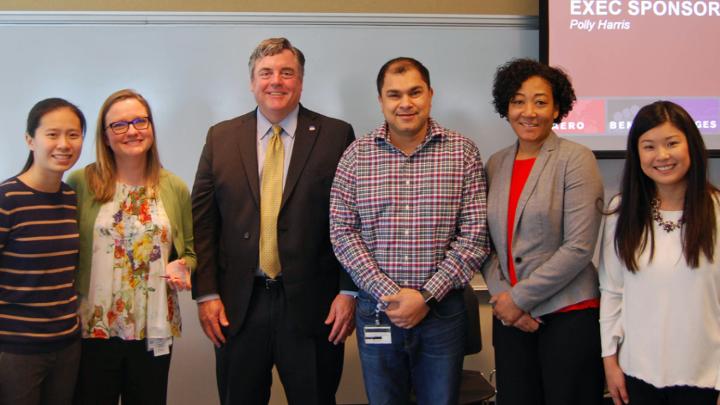
The executive sponsor for each ERG presented its leaders with the 2019 ERG Officer Award.
Giving Back In Our Communities
In addition to building a support structure and networking resource, ERGs give back in the communities where employees live and work. Employees work together to hold donation drives for clothing, backpacks, food, blankets and toys. The sense of camaraderie is rewarding in more ways than one.
“Service to others in the community is good for the soul and it feels good to help those in need,” said Derwin Davis, senior recruiter-Workforce Resources. “We have great people working within our ERGs who understand the importance of giving back to the community. It’s not about self-promotion, but simply giving back selflessly.”
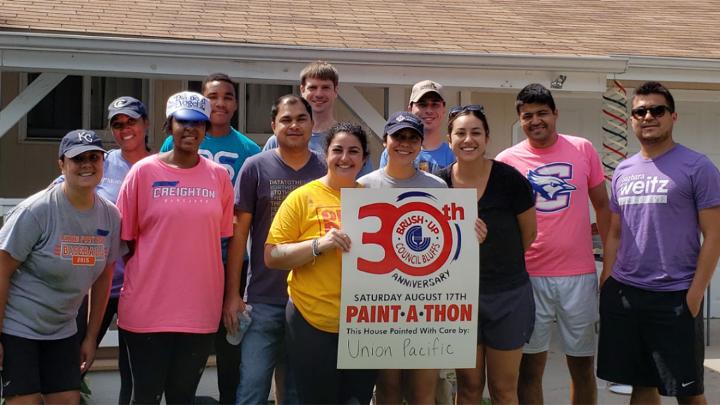
Fifteen Omaha-area volunteers from several ERGs participate in Brush Up Nebraska’s Paint-A-Thon, a community-based program that paints homes of qualified low-income elderly and disabled homeowners.
Encouraging Women to See Themselves At Union Pacific
Women make up approximately 5.5% of Union Pacific’s total workforce, a percentage that represents one of the company’s biggest diversity opportunities. We are working to double the representation of women to 11% by 2030.
Businesses such as ours face a growing shortfall of skilled trade workers due to fewer people choosing to learn a trade. We’re looking at potential barriers for women in this line of work and finding solutions to these roadblocks. For example, we’ve already addressed an important issue for nursing mothers through Milk Stork, a service that provides free overnight shipping of breast milk for women traveling for work. We also are taking steps to engage women who are furloughed, due to business volume, to make sure they’re ready to come back to work as soon as demand returns.
It’s important all employees have development opportunities and understand their career potential, and the many paths it can take. We’re examining each department to understand what the work looks like. If there are lower proportions of women within the group, we want to understand why. In some cases, this could mean redesigning the work to better support employees balancing work and family.
Just as important as retaining our employees is building a robust pipeline to recruit the very best and encourage women to see themselves succeeding at Union Pacific. Our careers website features stories of women working in Transportation, Engineering, Mechanical and Technical teams. We partner with skilled trade organizations, veterans groups, technical and trade schools, and affinity groups at multiple universities, sharing opportunities with women interested in pursuing a fulfilling career.
Union Pacific launched a partnership with FairyGodBoss.com, the largest career community for women. The website provides free expert career advice, job openings and company reviews written by women for women. We are just beginning this partnership, and we are excited to see how it develops.
‘Queen’ Davis Spreads Positivity
For Mechanical Service Operator Andrea Davis, the goal of each and every day at Union Pacific is to spread positivity. While carrying out her duties as a maintenance shop cleaner at Jenks Locomotive Shop in North Little Rock, Arkansas, she regularly checks in with railroaders of all trades, from management to craft employees.
Davis wanted to be a railroader since childhood, thanks to time spent watching trains with her father, and she wanted a “hands-on” job. She started her career as a locomotive mover before transferring to Jenks Locomotive Shop five years ago. Her service track skills come in handy, allowing her to fill in at the washhouse, polishing locomotives and engines to perfection before they undergo maintenance and inspection.
“I feel like a queen among kings, a mama hen,” Davis said. “There aren’t many women at Jenks, so I do my part by answering questions and mentoring others.”
Davis is an active union member, serving as the 15-year secretary for Chapter 718 of the National Conference of Firemen and Oilers. Her responsibilities include taking and reading minutes, answering questions, connecting members, and standing in for the local chairman, as needed. She also is an active Peer Support volunteer, providing friendship and support to peers experiencing a disabling injury, family illness, death or other crisis.
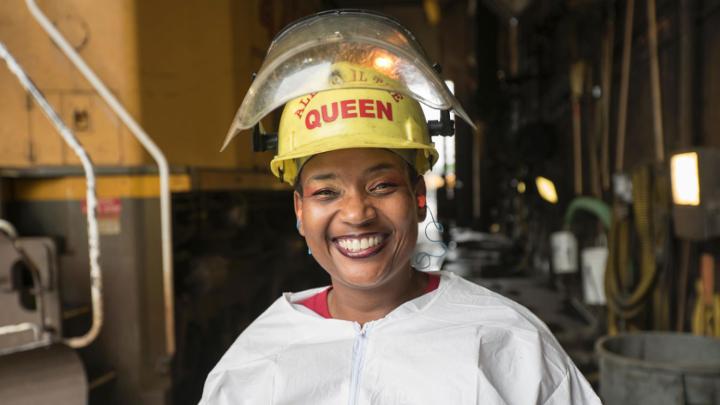
Andrea Davis brings spunk to every part of her day, from her “All Hail the Queen” hard hat to her conversations with colleagues.
Helping Young Girls Move Full “Steam” Ahead
If we want to see more women on the railroad, we have to expose them to career opportunities at any early age and show them what success looks like. Union Pacific joined forces with the Urban League of Nebraska and its Whitney M. Young, Jr. Academy to host a one-day workshop for the Girls Summer STEAM Academy. The academy exposed up to 20 girls of color in ninth through 12th grade to careers in Science, Technology, Engineering, Agriculture, the Arts and Mathematics through hands-on experiences. The workshop at Union Pacific gave participants a chance to try programming, bridge building and mechanics – careers offered at the railroad – while interacting with current female employees.
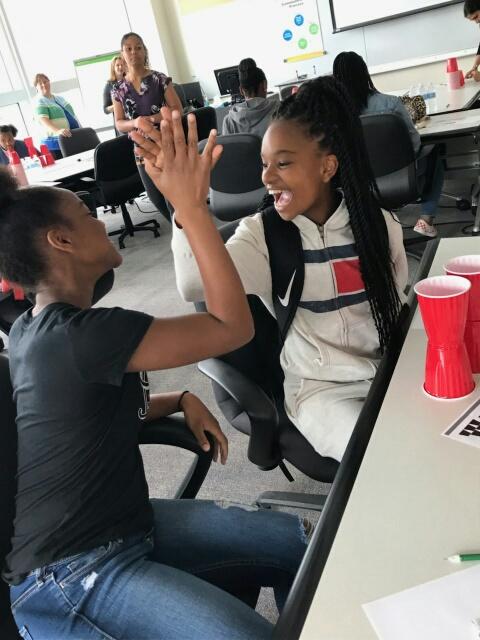
STEAM Academy participants complete an activity to program a robot cup at Union Pacific Center in Omaha, Nebraska.
Keeping Employees Healthy and Well
We are determined to help employees stay healthy. Our wellness programs help employees take charge of their well-being with tools to manage physical and mental health. Available resources include coaching, access to fitness centers, health education programs and screenings, and flu shots.
The System Health Injury Protocol program assists employees who may be at risk for injury because of low fitness levels. It provides access to personal training and nutrition consultations, helping employees achieve their fitness goals. When employees sustain injuries, Union Pacific’s Return to Work program offers meaningful work within their physical capabilities. We also provide education and assistance to help with substance abuse, staying alert and stress-related conditions.
Other employee wellness programs include:
- Personalized health coaching, helping employees and their spouses manage stress, depression, smoking, diabetes, nutrition education and weight management.
- Employee Assistance Program, offering all employees and their families counseling and referral services for personal or work-related problems.
- System health facility program, giving employees access to more than 5,000 gyms located near Union Pacific work sites.
- Incentives encouraging annual wellness assessments and physicals for non-union employees.
Sharing Best Practice On Peer Support
A central role in Union Pacific’s approach to well-being is filled by Peer Support networks, with trained employees offering confidential advice and guidance to their colleagues. This strengthens bonds and builds a sense of community within Union Pacific, providing support from those with an inherent understanding of the rail industry.
‘I Vowed To Make A Difference’
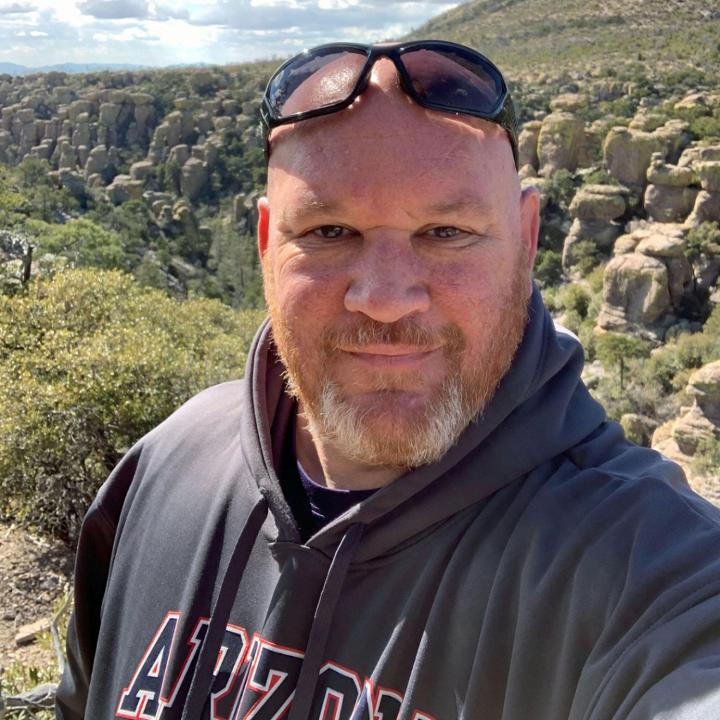
Locomotive Engineer David Sullivan provides Union Pacific employees resources as a Peer Support volunteer.
David Sullivan, a Tucson, Arizona-based locomotive engineer, became an Operation RedBlock and Peer Support volunteer in 2012 after a friend died from suicide. Unbeknownst to Sullivan, his friend and co-worker was a veteran suffering from post traumatic stress disorder.
“He reached out to me a few times, under the influence, and I didn’t know how to handle it,” Sullivan said. “After he died, I vowed to make a difference and be there for the next person. I would prevent it the next time.”
Union Pacific supports World Suicide Prevention Day – Sept. 10 – each year, spreading awareness and reminding employees of the importance of taking action to prevent suicides. Volunteers and occupational health nurses speak with employees systemwide about warning signs and resources for employees and their families.
Those in crisis or who know someone at risk should contact the National Suicide Prevention Lifeline at 800-273-TALK (8255).
Employee Assistance Program
We operate a 24/7 Employee Assistance Program helpline, providing access to trained employee volunteers. These volunteers are equipped to help colleagues work through the emotional impacts of life-changing events. Support is entirely confidential – and can provide a bridge to professional support services, where needed.
Employees Actively Serving
Some of Union Pacific’s first employees were Civil War veterans, and through our nearly 160-year history, we’ve consistently supported the military – whether by moving troops and supplies, or by providing good jobs for veterans and reserve-duty soldiers. We recognize that members of the U.S. military are dedicated individuals who bring unique experience and skills to Union Pacific. More than 17% of employees have military experience, with some still active in the National Guard or Reserves. In the last five years, 22% of new hires were veterans.
Union Pacific complies with the Uniformed Services Employment and Reemployment Rights Act (USERRA), which provides leave and reemployment rights for veterans, reservists, National Guard members and others serving in the armed forces. Every month, approximately 75 agreement and 10 nonagreement employees are deployed. We have a military liaison who serves as a point of contact for employees and their families during deployments, answering questions and handling any concerns.
Union Pacific’s Support our Troops initiative encourages employees to send messages to our railroad’s uniformed soldiers on active duty around the world. For the 16th year in a row, our employees sent an American flag, messages and care packages to colleagues stationed overseas on Memorial Day.
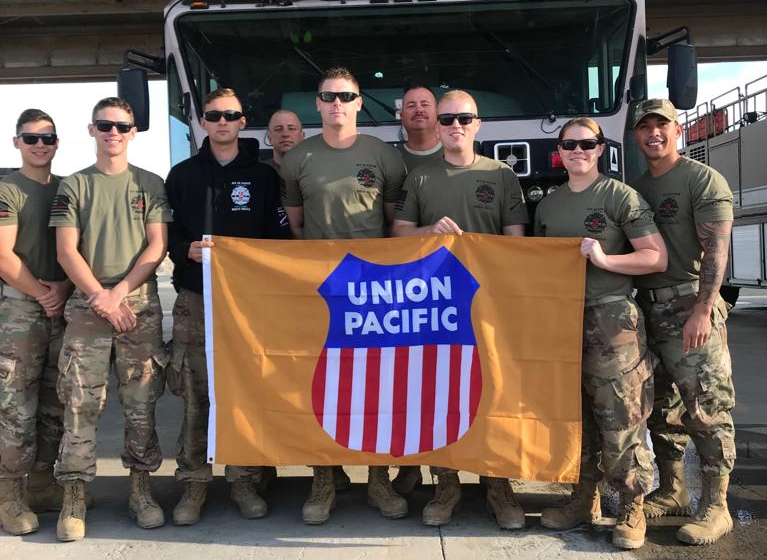
Brakeman Chris Tinsley, center, and his fellow firefighters hold a Union Pacific flag while deployed.
Scoops For Troops
Scoops for Troops, a fundraiser hosted by our UPVETS and UP Ties ERGs to support troops at home and abroad, is a summer tradition at Union Pacific Center in Omaha, Nebraska. Denver Broncos captain Andy Janovich helped kick off the 10th annual event. His father recently retired from Union Pacific, and both of his sisters are current employees. In total, 15 gallons of ice cream and 30 pounds of toppings were consumed by 275 employees, raising nearly $2,000 in donations.
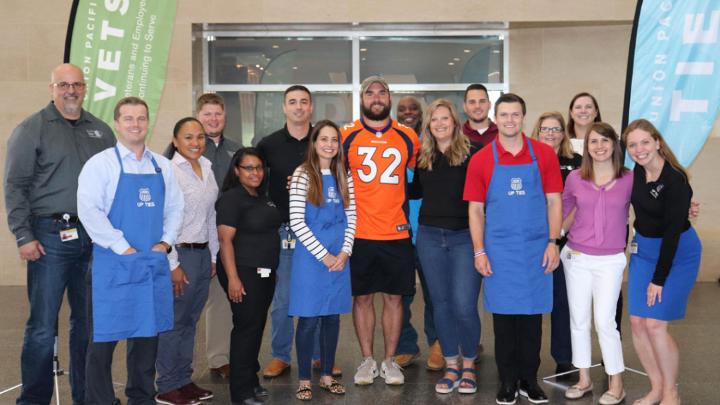
Members of the UPVETS and UP Ties leadership teams with Andy Janovich and OMT Catherine Antonio, third from left, a former Marine who spoke at the event.
Secretary Of Defense Executive Fellows Program
Every year, military officers from each branch of service are selected to receive senior service college credit by training with corporations, companies and commercial enterprises through the Secretary of Defense Executive Fellows Program. With 21 years in the Marine Corps, Lt. Col. Jamey Stover selected Union Pacific for his fellowship to broaden his logistics experience.
Stover served as a logistics officer on 13 assignments in six states and five naval ships. During his year at Union Pacific, he worked in Loup Logistics, familiarizing himself with carload and intermodal transportation, and even experiencing military marketing. Stover appreciated seeing strategy for military movements and recruiting from the other side. As we implemented Unified Plan 2020, Stover learned about asset utilization and efficiency - strategies he plans to take back to his Marine Corps logistics community.
Other companies hosting fellows in 2019 included Amazon, Google, Microsoft and Boeing.
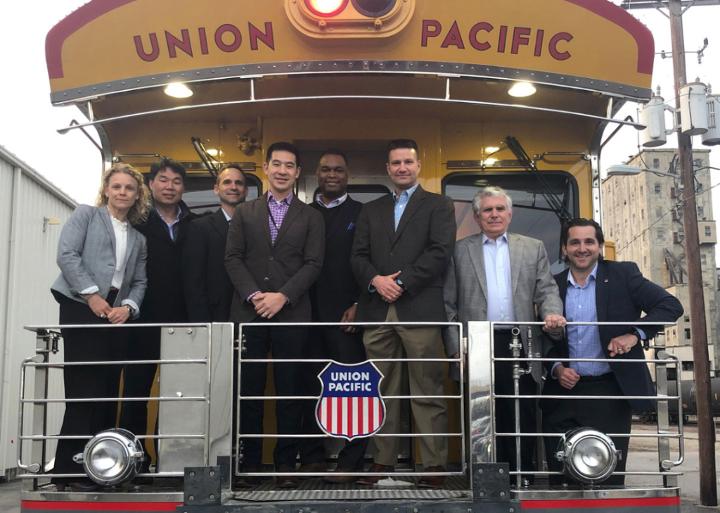
Jamey Stover, third from right, with Defense Fellows at a dinner onboard one of Union Pacific’s Heritage Fleet business cars.
What's Ahead
Improving employee engagement continues to be among our top priorities. We are redefining how our work is done by consolidating our eight core competencies into four, providing consistent development opportunities for every employee. We also plan to update our performance management system, encouraging feedback on a regular basis rather than only at mid-year and year’s end. This gives employees the opportunity to note and celebrate wins with their supervisor as they occur.
Effective Jan. 1, 2020, all nonagreement employees will receive an enhanced vacation benefit. Previously, our “use it or lose it” vacation policy limited vacation carryover at year’s end to a maximum of five days and required it be taken by March 31. Unused vacation will now carry over without an expiration date. The new policy also provides more frequent vacation increments. Rather than occurring at 10 and 20 years of service, the enhanced policy for nonagreement employees provides added vacation days at 7, 10, 15 and 20 years of service.
Union Pacific will continue to ask for employee feedback via surveys and focus groups. Through this work, employees requested additional voluntary benefit offerings. In 2020, we plan to launch a marketplace that leverages group purchasing power to provide discounted rates and convenient payment options for things such as auto, home/renters and pet insurance, as well as identity theft protection.
We plan to host a Peer Support leadership conference, bringing regional volunteers together to network, share best practices and build momentum for an important part of our well-being support structure. Peer Support provides invaluable resources to those facing crises at home or work.
